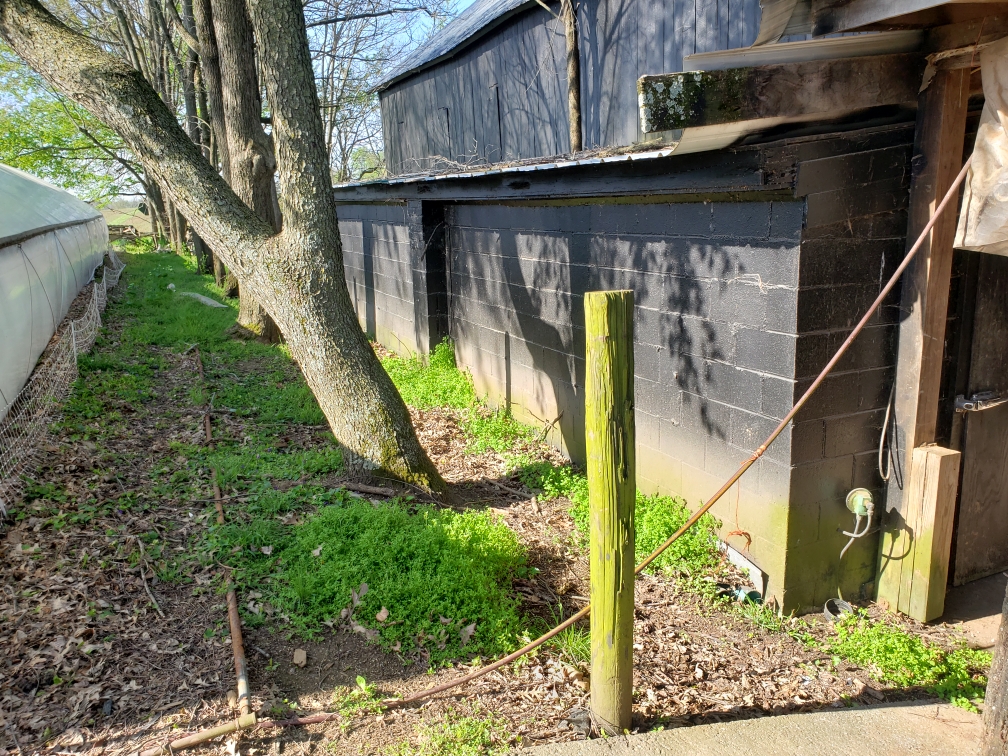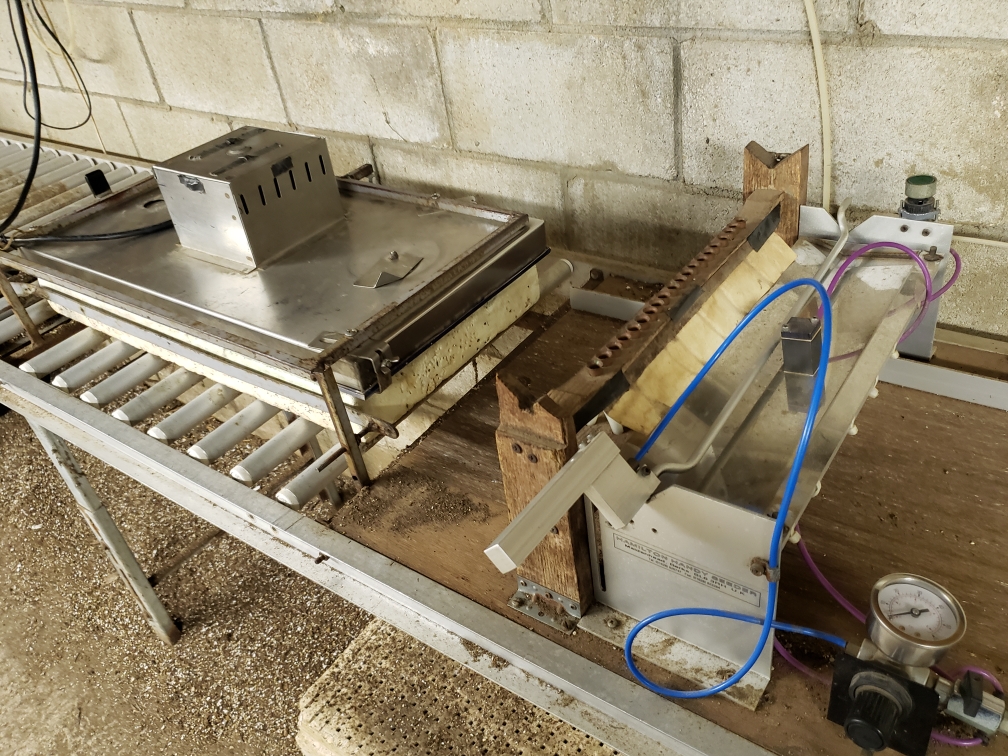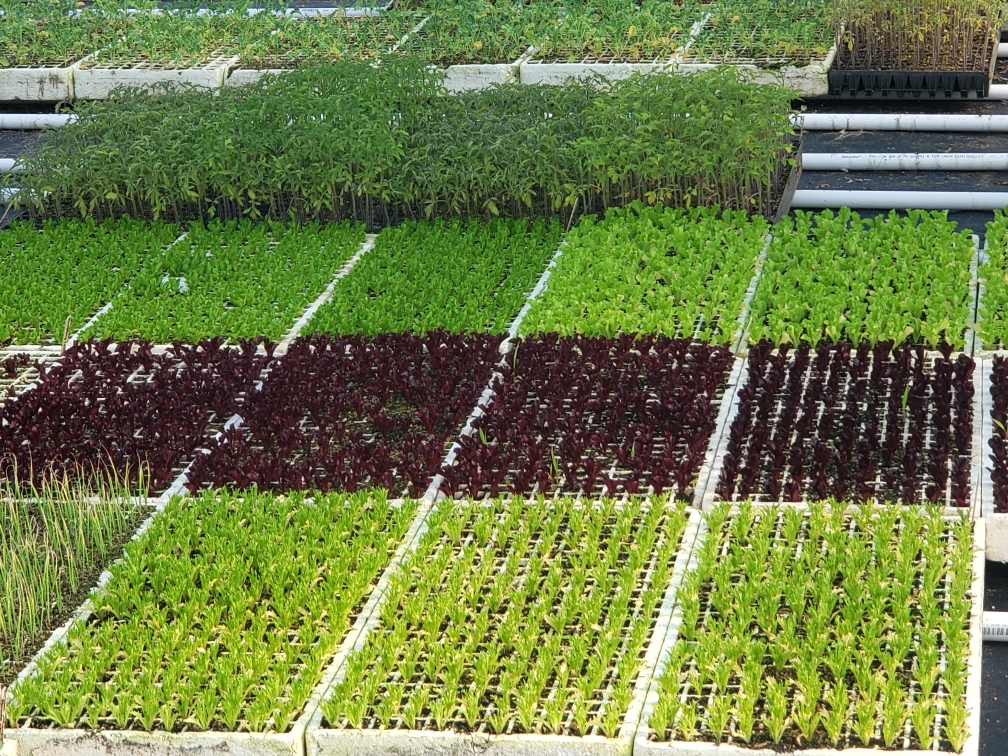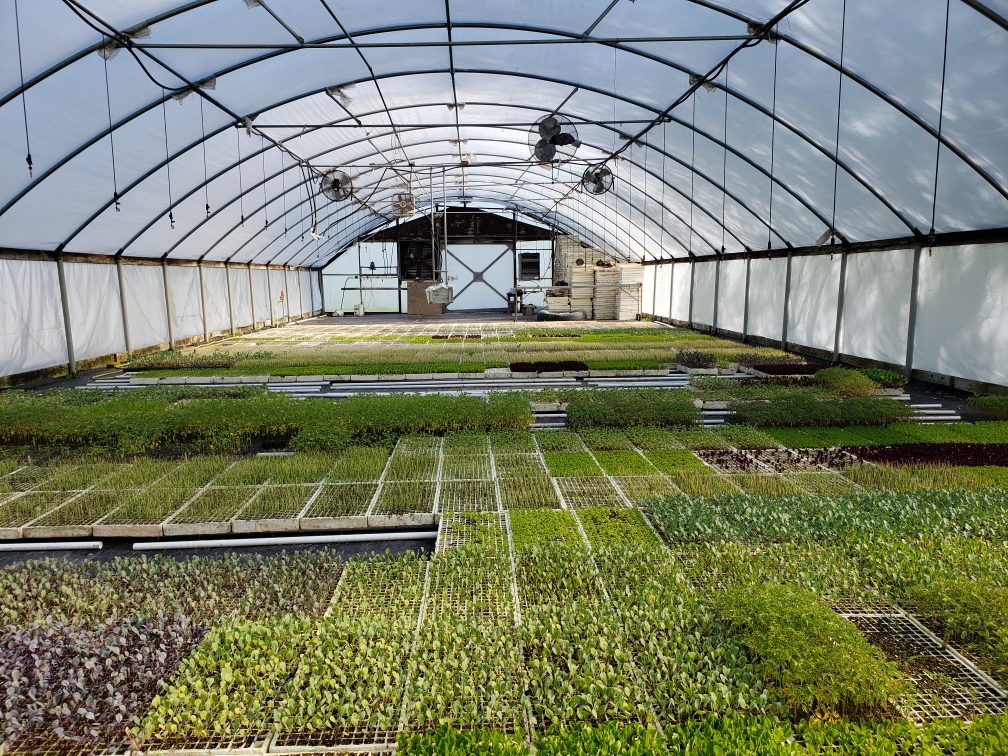Mac’s story this week is the last one he wrote before Covid-19 came to town. While you’re healthy at home, we’ll diverge from the conversation at hand for a bit and show you around the farm. When movement restrictions are eased, we look forward to having you out to see for yourself.

The Seed Room
Tucked away between the front tobacco barn and the ginger house, overhung with young trees, is the seed room. This old, concrete-block tobacco-stripping room attached to the tobacco barn has been retrofitted into a vegetable-transplant incubator. Long a secure refuge out on the farm, stripping rooms across the Commonwealth—now relics of the past—prepped the tobacco for sale. You see them all over Central Kentucky once you start looking. Now used for seed-starting instead of tobacco-stripping, ours continues to bring stories to life, and stripping room stories are legendary.
Before we explore the seed room, for reference, let’s reminisce about stripping rooms, with reverence. A quick tutorial on why stripping rooms exist: Tobacco plants in the field are cut at their base with a lightweight hatchet (simply called a knife). The stalk is speared onto a wooden stick with four or five others, thousands of these plant-laden sticks are hoisted into the tier rails of a tobacco barn and equally spaced out to dry. When the leaves have cured, the sticks are handed down (eight or 10 men were better than five or six) for the individual leaves to be stripped from the stalk and bundled for efficient delivery to the warehouse for sale. Farm families, friends and hired hands spent generations huddled in similar heated-block rooms across the Commonwealth, ‘strippin baccer.’ Fancy ones had an outhouse. The dusty, often-smoky air was welcoming, as it meant the once-a-year paycheck was in hand. All the toils and worrying about the weather coming to fruition listening to Caywood Ledford, voice of the Kentucky Wildcats, thanks to The Rural Electrification Project.
The stripping room on the front barn here on Elmwood Stock Farm has also housed weak or chilled lambs, thawed out countless hoses, given refuge from powerful thunderstorms, made working on small equipment bearable in winter, and stored all manner of stuff over the last 70-some-odd years.
After the tobacco buyout in the late 90s, the stripping room became vestigial, affording us the opportunity to repurpose it in some way, but how? The tobacco-transplant houses began growing tomatoes and other transplants during the decline in the tobacco market, as vegetables represented the logical alternative to tobacco as a cash crop. We were using one end of the greenhouse to fill seed trays and germinate all these seedlings—not ideal for all parties considered. With vegetables on the rise, we needed the working space in the greenhouse to grow transplants, so the stripping room, being right there, used mostly as a raccoon-safe catch-all, this bastion of prosperity, was converted to a pillar of hope.
The Makings of a Seed Room
First, the roof leaks that hadn’t mattered for quite some time had to be stopped. Next, a concrete floor was poured for cleanliness and thermal mass, and an old freezer-locker-type door installed to keep out the weather. Additional wiring, insulation and plywood on the barn-wall side, a vented propane heater, and viola, we have a five-star seed room.
Our seed-starting space is climate-controlled, clean, well-lit, with mouse-proof storage for seeds and potting soil, plus plenty of room to work. With some affordable homemade solutions, John set up a seed-starting assembly line just like the fancy ones in the catalog at half the price.

Before the Seeds
He fashioned a plywood potting-soil hopper near the start of a passive-roller conveyor line. The trays self-fill with soil as you pass each one through, and a screed bar scrapes off excess soil as each tray exits the chamber. This is not only way faster than hand-filling each tray, it more uniformly fills each cell of the tray with seed-starting soil mix.
Each styrofoam tray—another holdover from tobacco times—has 200 cells. To prepare each cell in the seed tray to accept a tiny seed, a little dent must be made in the soil for the seed to rest in. This keeps the seed nestled in the right moisture zone, not laying on top where it’s prone to drying out between waterings. As far as dibblers go, fingers work, and piano players can splay their fingers to create dents in four cells with each hand, moving across the tray pretty fast. I’m a two-finger guy, just like my typing right now.
Finger dibbling is fine if you’re just doing a couple of trays. More than a couple at a time, a dibble board comes into play. A dibble board is a piece of wood the same size as the seed tray with 200 little wooden balls screwed to the underside in the exact grid of the tray’s cells, thereby allowing us to dibble 200 all at once. Works pretty well, although it gets a tad heavy after a couple hundred trays.
To further up our dibbling game, Cecil welded 200 3/8-inch nuts to 22 18-inch-long pieces of strap iron, then molded them around two old lawnmower wheels. As the trays are pushed along the conveyor to exit the soil hopper, this wheeled device rolls along the tops of the trays, dibbling each cell. Cecil even accounted for the slightly wider divider where two trays abut one another. Looks a little Rube Goldberg; works perfectly.

Seeds, Meet Soil
But wait, the assembly line gets better.
Next down the line is the vacuum seeder. This is the one gizmo John bought—the heart of it all. When you’re seeding so many trays each week, you start looking for ways to automate. Picture a metal tray, slightly bigger than the seed trays, with 200 tiny holes on the underside to match up with the cells on the tray. A vacuum hose is connected to the internal chamber, so when you fill the seed chamber and tilt the tray toward you, the little round seeds get sucked, one each, to the little holes. You tilt and roll the thing around to get one seed in all 200 holes before pivoting it over the seed tray and sliding a lever to break the vacuum, allowing each seed to drop into the dibbled dent in the cell. Seed companies now put a clay coating on many odd-shaped seeds to turn them into little balls so this system will work. Another example of a success story in the buy local/organic food movement.
Flat seeds, like pepper and tomato, would be big as marbles with a clay coating—that’s not going to work. For seeds like this, John bought a vacuum-fitted wand with two rows of teeny-tiny holes along it. Similar to the vacuum seeder above, you use the wand to lift the right number of seeds out of a long, narrow tray, then hold the wand over two rows of cells in the seed tray. Take your thumb off the trigger hole to release the vacuum, and the seeds drop into the cells.
All of this is way faster than flicking little seeds into cells one at a time, like we still do with onions, swiss chard and squashes.
Tucking in the Seeds
But wait, we are not quite done. Further down the rollers is a home-lawn fertilizer spreader, bolted above the line. Here, we can spin the wheel while passing the tray underneath to cover the seed in the dibble hole with vermiculite, putting them in the optimum germination zone.
All of that, just to get all the seeds in the right place.
Waiting for Germination
From the rollers, the trays are proudly stacked in the germination room, where the magic happens.
Every seed since the beginning of time is pre-programmed to break dormancy when conditions are right. Good thing for us humans, all the yummy vegetables we start indoors come alive around 80 degrees F and high humidity. We easily simulate these conditions with a barrel full of water and a water-heating element enclosed in a room made by hanging sheets of plastic from the ceiling. That’s what we call the germ (germination) room.
Somehow, someway, hormones or something in the seed coat detect that conditions are right for root growth and crack themselves open, awakening the DNA within to express itself. The small dose of starch encapsulated within offers just enough energy to encourage cellular division of a root structure, called a radicle. The radicle’s job is to detect gravity and head toward the earth by adding new cells, ever so slowly forcing its mass between the soil particles around it. All the while, thousands of unbelievably small root hairs develop along this anchor, pulling in water and nutrients, and the DNA brain is calling for backup in the seed pod to send a leaf shoot rocketing to the sky.
We watch closely for our little radicles to stick their little heads out, at which time we cart the stacks of trays into the sunny expanse of the greenhouse. The trays are laid out in a grid, where the daily fluctuations in temperature begin—not good for uniform seed germination, but fine for seedlings. Overhead watering, either by hand with a hose wand, or with sprinklers on a timer, is all the little guys need for several weeks. Again, good thing for us humans, the stuff we start in the greenhouse likes it between 45 and 75 degrees F when they are little, which we can easily do by creating low tunnels—stretching plastic over some bowed pipes—and setting up a small propane heater and some fans.

Seeds Become Food
The seed list we submitted with our USDA organic certification packet totaled more than 250 uniquely different varieties of DNA, destined to capture solar energy and convert water into clean, tasty plant material on our behalf. Each is programmed to require slightly different conditions, which complicates things, but a little TLC goes a long way.
The stories coming out of the seed room extend all the way to your dinner table. Thank you for the kind words as you relay tales of eating good food with friends and family. As you enjoy the fruits of our labor, think about the little seeds from whence they came. Organic seed farmers out there maintain a diverse gene pool of edible plants and make them available to us. Another success story of the local/organic food movement. Looks like our little concrete block room will be making more stories as we spend the hours tending to our seeds, listening to podcasts, working away in climate-controlled conditions. —Mac Stone



Made with 
